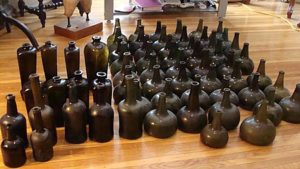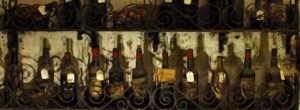Have you ever heard they saying that more ’82 Petrus was been sold and drank than was ever produced? When we think of counterfeiting we think of money and paintings, but counterfeit alcohol has become big business. Recently I have come across a few articles on both counterfeit wine and alcohol being sold across the world. While I worked for Southern Wine and Spirits I was able to attend a lecture by The Wine Detective Michael Egan, who told of his very fascinating work that he did with the FBI on a few cases of wine fraud.
Michael Egan is an assigned expert with the Compangnie Nationale des Experts MCHT in Paris, France and was accepted as a registered expert at the Bordeaux Appeal Court. He has not only worked for the FBI as an expert witness in the case of United States v. Kurniawan but been hired privately by plaintiffs suing people who have sold them counterfeit wines. Originally from England Michael worked for Sotheby’s Auction House in London, England for 24 years, becoming their wine director. In 2005 he moved to Bordeaux, France and has been authenticating commercial and private wine collections. His line of work has let him see and examine countless collections of authentic high end wines which makes him an expert.
When I first walked into the lecture I figured that to authenticate a wine you could just simply do some scientific chemical analysis and determine that it was a fake. Actually as Michael explained that yes this will prove grape varietals and give you an approximate age there are still several things wrong with this. First the bottle has to be opened, and when we are talking about a $30K magnum bottle of 82 Chateau Petrus, that isn’t always an option. Second there are numerous factors that can affect the outcome of the results such as exposure to heat, oxidation, and other storage issues that come with old wines. Instead Michael focuses more on the bottle its self. He will determine various things such as is this the type of bottle shape, color, and size they would have used. Next he examines the labels to see if not only the printing and designs are correct but that the paper is old enough and the technology of the printing and even the glue would have been used at that time. There is also an inspection of the cork to make sure that it is the appropriate length and has the correct markings and correct capsule.
Recently I read an article from the Associated Press about Rudy Kurniawan that inspired me to write this article since I remembered hearing about the case from Michael Egan himself. In Late 2015 the courts had ordered that the over 500 bottles of counterfeit wine that was being held in evidence from his conviction in 2013 to be destroyed at their location in Texas. US Marshals poured out every bottle into a compost pile and had a local recycling company haul away the glass bottles. Rudy also lost his appeal in the 2nd Circuit Applet Court located in New York, upholding his 10 prison sentence and approximately $25 million in fines and another $25 million in restitution. He filed his appeal alleging that the FBI did not have a properly obtained warrant to enter his house.
Rudy scammed people into buying his counterfeit wines by throwing elaborate parties where he would invite local millionaires to come for a meet and greet so he could make more friends. At his parties he would show off his extensive and expensive wine collection and pop plenty of pricy bottles for his guests. People would become so intrigued with his collection that they would inquire as to how he obtained them. He would respond that he was an avid wine collector and had undisclosed ways of scouring the world for the most prestigious bottles. Naturally they would want to get in on the action and he would tell them he would see what he could do. Then like magic a few weeks later he would call them up with the delightful news that he had found them their bottle. In actuality Rudy had purchased large quantities of lesser expensive Napa Valley and Burgundy wines and make a proprietary blend in his kitchen, then slap a knock off older vintage label of what you wanted on the bottle. Rudy was first accused of counterfeiting wines by Chateau Le Pin in 2007 when he attempted to sell several Magnum bottles of ’82 Chateau Le Pin to Christie’s Auction House in Los Angeles, California. A representative from the Chateau contacted the auction house and told them that they were fakes. Later that year Sotheby’s also accused him of selling counterfeit magnum bottles of ’47 Lafleur in 2006 stating that only 5 bottle had ever been produced. Then again in 2008 he was accused of counterfeiting wine by Domaine Ponsot as he attempted to sell their bottles ranging in vintage from 1945 to 1971, but the wine makes stated that he had never produced wine from the Grand Cru Appellation of Clos St. Denis before 1982. Later he was sued by billionaire wine collector Bill Koch in 2009 for selling him counterfeit wines. And finally in 2012 the FBI raided his home and ended his counterfeiting career.
Michael Egan stated that most of France’s high end wine producers are taking steps to ensure their wines are not counterfeited in the future by implementing such security measures as micro printing, watermarks, and etching of serial numbers to help protect themselves. Also they are making it harder for anyone outside of reputable importers and distributors to buy their product, and in purchasing their wines are contractually obligated to keep detailed records of their transactions so there becomes a paper trail for each bottle. But he did express a concern for more middle priced wines to be counterfeited since more people are less suspicious of wines that range from $500 a bottle to just a couple of thousand and the counterfeiters can make up the differences by moving larger quantities of wine at that price point. So if you get the opportunity to try an exceptionally rare wine, stop and think if was really made by whom and were it was suppose to be.
Michael Egan

